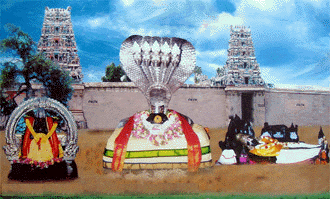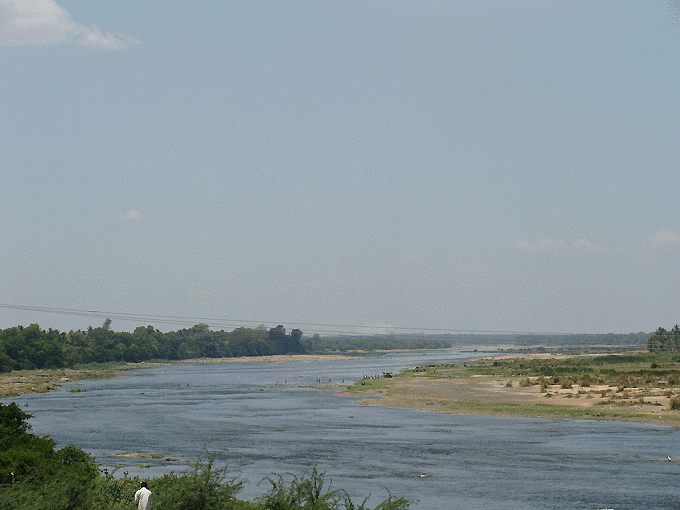
|
|
|
|
Known as a Trimurthy Sthalam, this temple has a Brahma linga shrine inside the main sanctum, as well as a shrine outdoors to Brahma and Saraswati together. The temple complex is described as having three main features: moorthy, which describes the Trimurti deities; theertham, which describes the holy River Kaviri (Cauvery) and the other sacred tanks, and sthalam, which describes the overall divine qualities of the place. In a test of strength between Adisesha and Vayu, which shook the area's holy Meru (divine hill), five gems are said to have been scattered from the head of Adisesha. Transforming into swayambulinga Sivasthalas, a red stone landed at Tiruvannamalai, an emerald at Eengoimalai (Thirueengoimalai), a blue diamond at Potikai (Kuttraalam), a manikkam at Vaatpoki (Sivaaya Malai), and a diamond here at Kodumudi. The place is also associated with the sage Agasthya, who worshipped here. While traveling to the South to tilt the balance of the earth, the waters of Agasthya's kamandalam flowed from Kodumudi as the Kaveri River, to alleviate the misery of the farmers downstream. In respect of endowments given by the Pandyan rulers, the Kodumudi Temple is also known as the Paandikkodumudi shrine. Several inscriptions on the temple premises record endowments from various royal dynasties. The lion-faced pillars testify to the Pallava's architectural influences. This temple construction is an excellent example of Tamilian stonework. As the reader will discover in this and subsequent articles on Tamil Nadu Brahma temples, a whole new lexicon of terms is used to describe the deities, temple architecture, and spiritual practices. Being specific to the Tamil dialect, they are markedly different from the nomenclature used to describe Kerala temples. While many of the deity names will be unrecognizable to those not familiar with Tamil culture, they are actually deity forms very familiar to most devotees.

Makuteswarer Temple's Gopurams Kodumudi Makuteswarer is a vast temple, with grand shrines to the presiding deities. The temple has three gopurams (towers), leading to the three main shrines, or mummoorthy (trimurthy) koil for Brahma, Vishnu and Shiva.
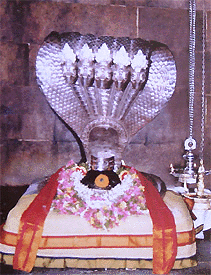
Lord Makuteswarer The presiding deity, after whom the temple is named is Makuteswarer (Malaikozhundheesar or Paandi Kodumudi nathar, Lord Shiva), who is here with Vadivudai-amman (or Soundaranayaki, Shiva's consort). Lord Brahma is here without his consort in the inner sanctum. Brahma and Vishnu once worshipped Shiva at this place, thus the name Trimurthy Kovil. Lord Visnu is known here as Veera-narayana Perumal or Ananthasayanam (Visnu on Anantasesa), with his consort Laksmi (Thirumangai Nachiyar, or Taayaar).
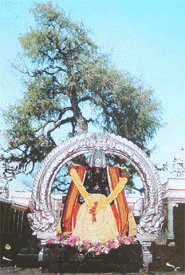
Lord Brahma Inside the shrine of Sri Maguteswarar, under one of the gopurams, devotees can circumambulate and get darshan of Nartana Ganapati, the murtis of 63 Nayanmars (famed Shaivite devotional poets of Tamil Nadu), Kaveri Kanda Vinayakar (Ganapati), Somaskandar (an utsava murthy, or deity taken on processional on festival days), Agasteeswarar (the sage), Arumugar with Valli and Devayani, Gajalakshmi, Vishnu on the sanctum wall, Shiva Natarajar, Sivakami with Manikkavasar, and Tripura-sundari.

Perumal Visnu The Vinayakar (Ganesh) here is referred to as Kaviri Kanda Vinayakar. A dancing Shiva Nataraj murti, called Kunchitapaada Natarajar (Kunjithapaatha Nataraja), has both his feet on the ground, in contrast to the typical raised left foot. On the West side are murtis of Vallabhi Ganesar, Sozhiswarar, Visveswarar, Kasi Viswanathar, Visalakshi, Saraswati, and Sapta Matas. The bronze murtis of Chandrasekara (Shiva) and Thripurasamhaaramoorthi (Trimurti) are excellent examples of fine Tamil artistry. For a period of four days during the months of Panguni and Aavani (Pisces and Virgo), the sunlight illuminates the sanctum of Shiva and Ambal.

Lord Brahma's Vanni Tree In the Perumal sannithi (Visnu shrine), the Lord is in reclining pose with Adishesa's protective hood over His head. In the centre of the sanctum wall is Lord Brahma, flanked by Naradar (Narada Muni) and Vasudeva, with Garuda and Sridevi. On the right are Vibheeshanan, Anjaneya, Sudarsana Chakram, and Bhoomadevi (Bhudevi). The Utsavar Moorthy is in front. Circumambulating the Visnu sanctum, one gets darshan of Tirumangai Azhwar, Garuda, Thondaradipodi Azhwar, Venkatachalapathi, Tirumazhishai Azhwar, Nagas, Kulasekhara Azhwar, Poygai Azhwar, Tirupaan Azhwar, Peyazhwar, Nammazhwar, Udayavar, Paramapadanathar.
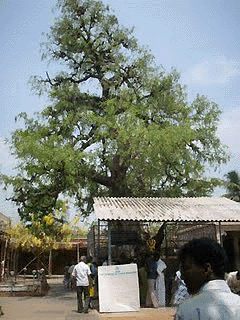
The Vanni Tree Outside the main temple complex are many additional shrines, including an open air sanctum dedicated to Lord Brahma, under a 3,000 year old Vanni tree (Sthala Vriksham). This is a three-faced Brahmadeva, and the tree itself is considered to be his fourth face. This tree bears no fruits or flowers. Half the three has thorns, while the other half does not; this is understood to be the representation of Brahma and Saraswati, together. Some date this tree as having been here since the time of the Pancha Pandavas.

Outdoor Visnu Shrine There are also outdoor shrines for Anjaneya, Thayar Thirumangai Nachiyar (adjacent to Perumal), and Saneeswarar. Veeranarayana Perumal's outdoor shrine has the Lord's head facing north, just like Srirangam, but this Perumal is even longer. Consort Thirumangai Nachiyar's outdoor shrine is just to the left. There is also a Sanishwarar shrine, where he is seen sitting on a crow, and a Hanuman shrine.

Temple Chariot Festival
Kodumudi Makuteswarer Temple is well known for its Navagraha Shanthi Homam and Navagraha murti pujas. Bhrammotsavam is celebrated in Chittirai (Aries), when the deities are taking out on procession. Sri Krishna Janmastami is celebrated, and at Aadipperukku, lighted lamps are floated out on the river. Devotees making pilgrimage to Kodumudi temple take bath in the River Kaviri and get the blessings of Vanni leaves. There are a number of traditional Tamil musical instruments also associated with pilgrimage here.

Garuda on a Kodumudi shrine roof
| |
